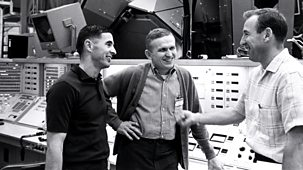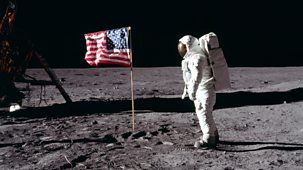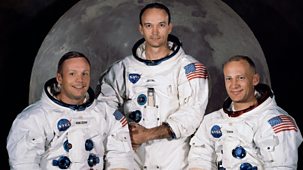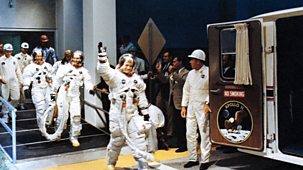
Series 1: 3. Earthrise - Part 1
What exactly was it going to take for America to beat the Soviets to the moon? Cold War tensions persisted, as rumours circulated that the Soviets were preparing to send an unmanned spacecraft to the moon. Nasa quickly developed the Gemini program, sending astronauts into orbit around the Earth to practice critical manoeuvres for the eventual trip to the moon. Ed White became the first American to walk in space, an experience so exhilarating that, when Houston ordered him back in the space craft, he replied, ‘Not yet!’. \n\nNasa’s next-generation spacecraft, Apollo 1, was meant to dramatically launch the new era. Virgil Grissom, Ed White and Roger Chaffee were Apollo’s very first crew. On a cool January day in Florida, in 1967, the three men suited up for a pre-launch training run in the new command capsule. Two and a half hours through the training, somewhere in the closed capsule, a fire broke out. The hatch design opened inwards and all three men perished. Mission control was powerless. The disaster shook the nation and left the future of Apollo, Nasa and the entire race to the moon in doubt. The cost perhaps was too high.\n\nA film By Robert Stone.\n\nA Robert Stone Production for American Experience WGBH/PBS in association with Arte France.
Source: BBC 4
Most recent episodes of Chasing the Moon
Chasing The Moon
Series 1: 6. Magnificent Desolation - Part 2
Viewers from around the world watched the flickering black-and-white footage from a camera placed on the module showing Armstrong gingerly stepping down its ladder. ‘OK, I ...
07-05-2024
BBC 4
Chasing The Moon
Series 1: 5. Magnificent Desolation - Part 1
After the immediate celebration of 1968’s successful Apollo 8 mission, underlying questions about the space programme emerged with new intensity as politicised young Ameri ...
07-05-2024
BBC 4
Chasing The Moon
Series 1: 4. Earthrise - Part 2
In the aftermath of the deadly Apollo 1 fire, Nasa faced harsh scrutiny. The horror of the first casualties at Cape Kennedy led Americans to increasingly question the very premi ...
30-04-2024
BBC 4
Chasing The Moon
Series 1: 3. Earthrise - Part 1
What exactly was it going to take for America to beat the Soviets to the moon? Cold War tensions persisted, as rumours circulated that the Soviets were preparing to send an unma ...
30-04-2024
BBC 4
Chasing The Moon
Series 1: 2. A Place Beyond The Sky - Part 2
Under von Braun’s leadership, America’s technology finally seemed to be catching up with the Soviet Union’s. On 5 May 1961, von Braun’s Redstone rocket s ...
23-04-2024
BBC 4
Chasing The Moon
Series 1: 1. A Place Beyond The Sky - Part 1
On 4 October 1957, Soviet scientists launched Sputnik 1 - a beach ball-sized, radio-transmitting aluminium alloy sphere - into orbit. The satellite caused a sensation. Amid Cold ...
23-04-2024
BBC 4
Most popular episodes of Chasing the Moon
Chasing The Moon
Series 1: 1. A Place Beyond The Sky - Part 1
On 4 October 1957, Soviet scientists launched Sputnik 1 - a beach ball-sized, radio-transmitting aluminium alloy sphere - into orbit. The satellite caused a sensation. Amid Cold ...
23-04-2024
BBC 4
Chasing The Moon
Series 1: 6. Magnificent Desolation - Part 2
Viewers from around the world watched the flickering black-and-white footage from a camera placed on the module showing Armstrong gingerly stepping down its ladder. ‘OK, I ...
07-05-2024
BBC 4
Chasing The Moon
Series 1: 2. A Place Beyond The Sky - Part 2
Under von Braun’s leadership, America’s technology finally seemed to be catching up with the Soviet Union’s. On 5 May 1961, von Braun’s Redstone rocket s ...
23-04-2024
BBC 4
Chasing The Moon
Series 1: 5. Magnificent Desolation - Part 1
After the immediate celebration of 1968’s successful Apollo 8 mission, underlying questions about the space programme emerged with new intensity as politicised young Ameri ...
07-05-2024
BBC 4
Chasing The Moon
Series 1: 3. Earthrise - Part 1
What exactly was it going to take for America to beat the Soviets to the moon? Cold War tensions persisted, as rumours circulated that the Soviets were preparing to send an unma ...
30-04-2024
BBC 4
Chasing The Moon
Series 1: 4. Earthrise - Part 2
In the aftermath of the deadly Apollo 1 fire, Nasa faced harsh scrutiny. The horror of the first casualties at Cape Kennedy led Americans to increasingly question the very premi ...
30-04-2024
BBC 4






